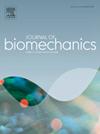Effect of decellularization protocols on the biomechanical properties of porcine ovarian extracellular matrix
IF 2.4
3区 医学
Q3 BIOPHYSICS
引用次数: 0
Abstract
Decellularized extracellular matrix (d-ECM) serves as an ideal scaffold for constructing artificial ovaries, a promising approach to fertility preservation for patients experiencing premature ovarian failure. The biomechanical properties of d-ECM are crucial for the development and maturation of follicles. However, there is no standardized or comprehensive framework for evaluating the various decellularization methods proposed in the literature. In this study, we developed a novel decellularization protocol for porcine ovaries using liquid nitrogen and hypertonic saline methods, comparing its effectiveness against conventional chemical and enzymatic techniques through histological analysis, quantitative assessments and biomechanical testing. Histological analyses demonstrated that our d-ECM protocols effectively removed cellular and nuclear materials (at least 95% reduction) while preserving the structural integrity of elastin and collagen fibers (maximum 15% reduction). Furthermore, tensile testing results indicated that the novel decellularization methods using liquid nitrogen and hypertonic saline retained mechanical properties most similar to those of the fresh group. Our findings expand the evaluation of decellularization techniques by incorporating the biomechanical properties of d-ECM. Additionally, we provide valuable insights for enhancing decellularization methods and identifying optimal scaffolds for artificial ovaries.

脱细胞方案对猪卵巢细胞外基质生物力学性能的影响
脱细胞细胞外基质(d-ECM)是构建人工卵巢的理想支架,是卵巢早衰患者保存生育能力的一种很有前景的方法。d-ECM的生物力学特性对卵泡的发育和成熟至关重要。然而,没有一个标准化或全面的框架来评估文献中提出的各种脱细胞方法。在这项研究中,我们开发了一种新的使用液氮和高渗盐水方法对猪卵巢进行脱细胞的方案,并通过组织学分析、定量评估和生物力学测试比较了其与传统化学和酶技术的有效性。组织学分析表明,我们的d-ECM方案有效地去除细胞和核材料(至少减少95%),同时保持弹性蛋白和胶原纤维的结构完整性(最多减少15%)。此外,拉伸试验结果表明,使用液氮和高渗盐水的新型脱细胞方法保留了与新鲜组最相似的机械性能。我们的研究结果通过结合d-ECM的生物力学特性扩展了对脱细胞技术的评估。此外,我们还为改进人工卵巢的脱细胞方法和确定最佳支架提供了有价值的见解。
本文章由计算机程序翻译,如有差异,请以英文原文为准。
求助全文
约1分钟内获得全文
求助全文
来源期刊

Journal of biomechanics
生物-工程:生物医学
CiteScore
5.10
自引率
4.20%
发文量
345
审稿时长
1 months
期刊介绍:
The Journal of Biomechanics publishes reports of original and substantial findings using the principles of mechanics to explore biological problems. Analytical, as well as experimental papers may be submitted, and the journal accepts original articles, surveys and perspective articles (usually by Editorial invitation only), book reviews and letters to the Editor. The criteria for acceptance of manuscripts include excellence, novelty, significance, clarity, conciseness and interest to the readership.
Papers published in the journal may cover a wide range of topics in biomechanics, including, but not limited to:
-Fundamental Topics - Biomechanics of the musculoskeletal, cardiovascular, and respiratory systems, mechanics of hard and soft tissues, biofluid mechanics, mechanics of prostheses and implant-tissue interfaces, mechanics of cells.
-Cardiovascular and Respiratory Biomechanics - Mechanics of blood-flow, air-flow, mechanics of the soft tissues, flow-tissue or flow-prosthesis interactions.
-Cell Biomechanics - Biomechanic analyses of cells, membranes and sub-cellular structures; the relationship of the mechanical environment to cell and tissue response.
-Dental Biomechanics - Design and analysis of dental tissues and prostheses, mechanics of chewing.
-Functional Tissue Engineering - The role of biomechanical factors in engineered tissue replacements and regenerative medicine.
-Injury Biomechanics - Mechanics of impact and trauma, dynamics of man-machine interaction.
-Molecular Biomechanics - Mechanical analyses of biomolecules.
-Orthopedic Biomechanics - Mechanics of fracture and fracture fixation, mechanics of implants and implant fixation, mechanics of bones and joints, wear of natural and artificial joints.
-Rehabilitation Biomechanics - Analyses of gait, mechanics of prosthetics and orthotics.
-Sports Biomechanics - Mechanical analyses of sports performance.
 求助内容:
求助内容: 应助结果提醒方式:
应助结果提醒方式:


